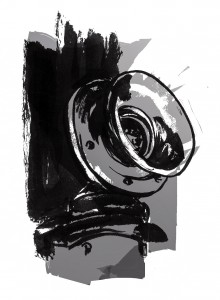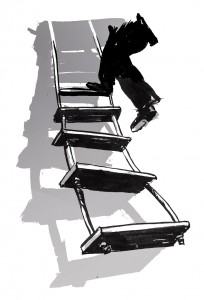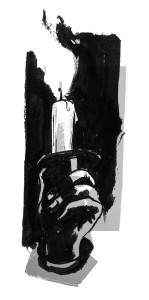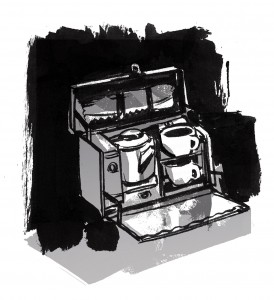John Franklin Goucher at Sea
By Marilyn Southard Warshawsky ’68
In a new biography, Marilyn Southard Warshawsky ’68, tells the story of John Franklin Goucher, educator, world traveler, philanthropist, a founder of the Woman’s College—and occasional maritime hero. Here is an excerpt from John Franklin Goucher: Citizen of the World.
ON JANUARY 22, 1909, IN NEW YORK, on a sunny and mild Friday afternoon, John Franklin Goucher and his friend, S. Earl Taylor, embarked as first-class passengers on the Republic, a five-year-old, 570-foot steamship of the White Star Line, bound for Alexandria, Egypt. By evening, as the ship headed out toward the Atlantic, the weather changed, and a fog “as thick as smoke” descended. At 5:30 the next morning, ship’s captain Inman Sealby was at the helm, peering into the darkness, when he suddenly heard another ship’s foghorn close by—too close. It was the steamer Florida, about half the Republic’s size, inbound from Naples, carrying more than 800 refugees from a recent earthquake in Sicily and southern Italy, and thirty miles off course in the fog.
 Sealby gave two sharp blasts of his horn to warn the other vessel to turn to port, as the Republic did the same, hoping to avert a collision. But the Florida’s bow struck the larger ship in the side, ripping apart two cabins on the upper deck and breaking through the steel plates that protected the engine room. Then the Florida pulled away into the fog, part of her crumpled bow still stuck in the wreckage. The two ships were more than 200 miles from New York and nearly eighty miles from the nearest land.
Sealby gave two sharp blasts of his horn to warn the other vessel to turn to port, as the Republic did the same, hoping to avert a collision. But the Florida’s bow struck the larger ship in the side, ripping apart two cabins on the upper deck and breaking through the steel plates that protected the engine room. Then the Florida pulled away into the fog, part of her crumpled bow still stuck in the wreckage. The two ships were more than 200 miles from New York and nearly eighty miles from the nearest land.
Goucher and Taylor were awakened by the foghorns; then they felt several bumps and heard grinding sounds not far from their cabin. Taylor stuck his head out the porthole and saw a gaping hole in the hull less than fifty feet away. Soon the lights went out as the ship’s engines were shut down. After dressing by the light of the electric torch [flashlight] Goucher always traveled with, Taylor went up on deck to investigate and returned to advise his companion to join him topside. Goucher declined, saying, “It is very comfortable here, and I’ll see the damage in the morning.” Even after stewards, carrying candles, came around and ordered all passengers to don life preservers and assemble on the saloon deck, Goucher calmly took his time. As he later recounted in his diary:
I opened my trunk and took out my warmest and lightest clothing I had, so as to have the greatest warmth with the least bulk if we had to take to the water, and put my cardigan jacket under my [life] vest so I could do without an overcoat if needed. I placed in my pocket my letter of credit, air pillow, barometer, tea case, and several other things that might be of service to the passengers, locked my trunk and clasped it carefully and started for the upper deck.
On deck, Captain Sealby told the assembled throng that the ship’s watertight compartments were holding and there was no immediate danger. But he warned them to be ready to take to the lifeboats if necessary.
When Goucher looked around, he noted that “the passengers presented a strange sight, many of them being very inadequately dressed in whatever they had seized in the dark.” Some were barefoot or wore mismatched shoes; women’s previously carefully coiffed hair, let down for the night, was still in braids; and jewelry had been left behind. Despite the abrupt change in their status, there was no panic. There was confusion, however, as the passengers huddled in groups, trying to find safe spots on deck or attempting to put on life preservers under the feeble glow of a few candles held by stewards. Using his pocket electric torch, Goucher passed “from one knot to another,” demonstrating to women and children how to correctly adjust their life belts.
AS DAWN APPROACHED, he chose an out-ofthe- way place to await further instructions—the skylight over the smoking room, drier than the deck and protected from the wind by the pilothouse and bridge. Some women who were traveling alone asked to join him, and he helped them climb up, but they still shivered in the biting cold. Before long he had made half a dozen trips below to retrieve clothing, shoes, and blankets for them, once over the captain’s objection. He even took one woman to her cabin, providing some light for her until, he said, “She had completely dressed, even to her hat and veil.”
Goucher’s assistance was only beginning. Five steamships and several other boats in the area had received the Republic Marconi operator’s distress call and searched for the ship in the dense fog. The Florida had withdrawn to assess its own damage, and the Republic had drifted some miles from the collision site; the ships remained invisible to each other. Only the dying blasts of the Republic’s steam whistle allowed the Florida to find it again. Although the Florida’s prow was smashed almost to the bridge, it too had watertight compartments, and it seemed in less danger than the Republic, which was sinking a foot every hour.
 Early Saturday morning, not knowing when another vessel might reach them, Sealby contacted his counterpart on the Florida via megaphone, and they agreed to transfer the Republic’s passengers and most of its crew to the smaller ship, then a half-mile away. To handle the mass evacuation, the captain asked for male volunteers to help row the lifeboats. But even before these craft reached the water, there were hazards to face. The small boats had been lowered over the side of the Republic and hung ten or twelve feet below the high railing. Both rowers and passengers, wearing cumbersome life vests, had to climb down what was described as “a swinging sea ladder” before settling in for the ride.
Early Saturday morning, not knowing when another vessel might reach them, Sealby contacted his counterpart on the Florida via megaphone, and they agreed to transfer the Republic’s passengers and most of its crew to the smaller ship, then a half-mile away. To handle the mass evacuation, the captain asked for male volunteers to help row the lifeboats. But even before these craft reached the water, there were hazards to face. The small boats had been lowered over the side of the Republic and hung ten or twelve feet below the high railing. Both rowers and passengers, wearing cumbersome life vests, had to climb down what was described as “a swinging sea ladder” before settling in for the ride.
Despite his age (sixty-three), two recent hernia operations, and his slight frame, Goucher stepped forward to help, and as a news article would describe, he “rowed as well as the younger ones.” Most people remained calm, even though their destination, the Florida, “could barely be made out under the search light [before it] faded away into the mist.” Where a few men abandoned their oars as soon as they reached the ship, Goucher refused. For nearly two hours, with the temperature near freezing, he helped ferry several loads of passengers across what he described as “an oily, fog-shrouded sea.” Once aboard the Florida, he and his fellow rescuees huddled together—tired, cold, and hungry. The supplies he had brought with him from his cabin came in handy: His tea case, he said, “helped a number of ladies who had sick headaches,” and his air pillow “gave two others in turn comfortable rests.”
At first it was thought the smaller Florida, with her engines intact, could carry her load safely to New York. But in the end it was the Baltic, a sister ship of the White Star Line, that came to the rescue. Sailing at less than capacity, it had room to take on the 1,650 passengers and crew from the two damaged vessels, plus more than 3,000 sacks of mail retrieved from the Republic.
 Goucher recorded the Baltic’s arrival on January 23: “For nearly 10 hours she cruised within 1 or 2 miles of us till after dark, when she saw our rockets. Cir. 10 PM we heard her foghorn and soon saw her lights.” As midnight approached, and using the twenty small lifeboats available between the two vessels, the ten-hour transfer began in the still foggy darkness, broken only by the Baltic’s searchlights. At first the larger ship was more than a mile from the Florida, as the sea grew increasingly rough. Goucher described his own ride:
Goucher recorded the Baltic’s arrival on January 23: “For nearly 10 hours she cruised within 1 or 2 miles of us till after dark, when she saw our rockets. Cir. 10 PM we heard her foghorn and soon saw her lights.” As midnight approached, and using the twenty small lifeboats available between the two vessels, the ten-hour transfer began in the still foggy darkness, broken only by the Baltic’s searchlights. At first the larger ship was more than a mile from the Florida, as the sea grew increasingly rough. Goucher described his own ride:
The sea was running high and it was very difficult to land and as we approached [the rope ladder of the Baltic], the officers ordered our boat to keep away as the ship was just starting to steam over, under the lee of the Florida to make the transfer of the passengers quicker and easier. Our small boat went back to the Florida and took on eight more passengers—notwithstanding the protest of one of the women that we should not let anyone else in—[A]fter more than an hour and a half, beating around in the small boat, we reached the Baltic at 4:30 AM where some warm soup and a good cabin made us comfortable.
BY EARLY SUNDAY MORNING, all from the Republic and the Florida, except for the captains and a few sailors who remained with their ships, had been safely transferred, and the Baltic began its journey to New York. Goucher slept for a short time in his new cabin, his first rest in more than twenty-four hours, and eventually he was able to send a wireless to his daughters, telling them he was safe. After breakfast, he slept again, waking in late afternoon to take part in “a very profitable service in the cabin” in thanksgiving for their safe deliverance.
As the Baltic reached New York Monday afternoon, January 25, the bedraggled Republic passengers were greeted by what a newspaper called the “welcome music of thousands of voices raised in a chorus of cheers.” They came down the gangplank, three days after they had departed, with no baggage and wearing the motley garments they had grabbed hastily in the dark two days before—“men in pajamas and blankets, children in almost nothing, women in all sorts of makeshifts in the way of garb.” All were glad to be back on solid ground, and a tired but “smiling and calm” Goucher joined his friends waiting on shore.
While Goucher was modest about his own role in the rescue, a Baltimore editorial praised him as a local hero:
Dr. Goucher, president emeritus of the Woman’s College, not only gained credit for himself, but reflected credit upon the city that holds him in high esteem as by his signal act of chivalry and self-abnegation in the trying hours of the Republic’s disaster. The circumstances were those of great fatigue, as well as great danger, but this college president, who has always preached the doctrine of manly graces combined with modesty, bent to the oar and refused to be relieved as boatload after boatload of passengers were conveyed from ship to ship.
 For his part, Goucher would only comment, “I did only what I conceived as my duty; that was all.” But his travel companion Taylor testified, “One woman after another came up to Dr. Goucher and thanked him for his kindness.” The many letters he received congratulating him on his safe return included one from Woman’s College professor Lilian Welsh: “I knew you would give moral strength and spiritual comfort to your fellow passengers, but I did not for a moment think of your giving physical assistance in the work of rescue…Nothing has affected me so deeply as the fact that you helped man a lifeboat. I can see you smile and say, ‘Why not?’ Yes, being you, why not?”
For his part, Goucher would only comment, “I did only what I conceived as my duty; that was all.” But his travel companion Taylor testified, “One woman after another came up to Dr. Goucher and thanked him for his kindness.” The many letters he received congratulating him on his safe return included one from Woman’s College professor Lilian Welsh: “I knew you would give moral strength and spiritual comfort to your fellow passengers, but I did not for a moment think of your giving physical assistance in the work of rescue…Nothing has affected me so deeply as the fact that you helped man a lifeboat. I can see you smile and say, ‘Why not?’ Yes, being you, why not?”
After docking in New York three days after his departure, Goucher caught a train to Baltimore. He already had telephoned his Thomas Cook travel agent to book passage for another trans-Atlantic crossing barely forty-eight hours later; arriving at the Baltimore station Monday evening, he made a reservation for a sleeper compartment on the Tuesday night train back to New York. The ordeal of the preceding days would not make him cancel his travel plans.
Marilyn Southard Warshawsky is a longtime Goucher College trustee and former chair of the Board of Trustees. Her book, John Franklin Goucher: Citizen of the World, is available from www.goucherbook.com.
Text notes:
Diary of John F. Goucher, January-February 1909;
The New York Times, January 24-26 and February 5, 1909;
The Baltimore Sun, January 24-27, 1909; Baltimore News,
January 25, 1909;
Baltimore American, January 27, 1909;
Chicago Tribune, January 26, 1909;
Lilian Welsh to John Goucher, January 25, 1909.
